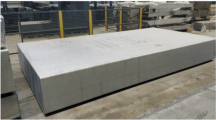Abstract
The purpose of this research was to assess what improvements might be obtained in the bend ductility of beryllium sheet by starting with high purity commercial powder and consolidating it into sheet by techniques that minimized deformation and texturing. Sound sheet was achieved with reduction ratios from 2∶1 to 12∶1 at temperatures from 700° to 1050°C by forging, upsetting and compression rolling. Compression rolling is accomplished by successively changing the rolling direction by 30 deg after each pass so that no preferred rolling direction was developed. It was found that as the plastic bend ductility increased (up to 4 pct) the yield strength decreased. The higher bend ductilities corresponded to lower reduction ratios, lower degrees of preferred orientation and a larger subgrain size as determined by transmission electron microscopy. Sheet prepared by commercial rolling practices from the less pure commercial powder exhibited similar behavior. The ductile-to-brittle transition temperature for bending decreased with improved purity and reduced texture.
Similar content being viewed by others
References
D. W. White and T. E. Burke:The Metal Beryllium, ASM, Cleveland, Ohio, 1954.
G. E. Darwin and J. H. Buddery:Beryllium, Academic Press, New York and London, 1960.
The Metallurgy of Beryllium, Chapman and Hall Ltd., London, 1963.
London Conference on Beryllium, Oct. 1961, The Inst. of Met., Chapman and Hall, London.
Gatlinburg Conf. on the Phys. Met. of Beryllium, USA, April 1963, U.S.A.E.C., Div. Tech. Info., Oak Ridge, Tenn.
Philadelphia Conf. on Beryllium, Oct. 15–17, 1964. Met. Soc. of AIME, Gordon and Breach, New York.
Grenoble Conf. on Beryllium, May 1965, Presses Univ. de France, Paris.
C. J. Greniza:The Metallurgy of Beryllium, The Inst. of Met., Chapman and Hall, London, p. 207, 1963.
M. B. Hornak, E. M. Grala, R. G. O'Rourke, G. L. Marsh, and L. S. Busch: Final Report on Rolling Improved Beryllium Sheet, The Brush Beryllium Co., M.-TDR-64-193, April 1964.
M. Herman and G. F. Spangler:The Metallurgy of Beryllium, p. 75, Chapman and Hall, London, 1963.
G. London, V. Damiano, and H. Conrad:Trans. TMS-AIME, 1968, vol. 242, pp. 979–94.
H. Conrad, G. London, and V. Damiano:Anisotropy in Single Crystal Refractory Compounds, vol. 2, F. W. Vahldick and S. A. Mersol, eds., Plenum Press, New York 1968.
G. London and V. Damiano: Flow and Fracture Characteristics of Zone Purified Beryllium and Selected Beryllium Rich Alloys, FIRL Final Report F-B2373, Contract NOw 63-0437-d, June 1966.
V. Damiano, M. Herman, and D. Hoover:Trans. TMS-AIME, 1966, vol. 236, pp. 829–32.
Author information
Authors and Affiliations
Additional information
M. HERMAN, formerly with The Franklin Institute Research Laboratories
H. CONRAD, formerly with The Franklin Institute Research Laboratories
Rights and permissions
About this article
Cite this article
Cooke, F.W., Herman, M. & Conrad, H. Effect of purity and processing procedure on the mechanical properties of beryllium sheet. Metall Trans 2, 1297–1305 (1971). https://doi.org/10.1007/BF02913352
Received:
Issue Date:
DOI: https://doi.org/10.1007/BF02913352



